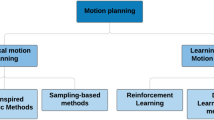Abstract
Six degrees-of-freedom (DoF) robot manipulators are dynamically coupled and highly nonlinear multi-variable systems. Calculating the optimal joint angles from the operational space (i.e. inverse kinematics) and designing the optimal joint controller parameters are two important research topics. This paper proposes a 3-stage Particle Swarm Optimization (PSO)-based methodology for solving the inverse kinematics and optimizing the controller parameters. In the first stage, a PSO algorithm solves the inverse kinematics problem by minimizing a multi-objective cost function in the operational space (i.e. the error in the end-effector’s pose) and therefore finds the optimal joint angles. In the second stage, polynomial functions generate the desired trajectory between the initial and final poses in the joint space. Finally, a second PSO algorithm tunes six proportional-derivative (PD) controllers, one for each joint, to track the desired trajectory by minimizing another multi-objective cost function in the joint space. Two case studies, based on six DoF Puma 560, validate the performance of the proposed methodology. Simulation results show that the proposed 3-stage methodology provides fast and accurate results as the PSO algorithms are effective in solving the inverse kinematics problem and tuning the optimal PD parameters.














Similar content being viewed by others
References
Siciliano B, Sciavicco L, Villani L, Oriolo G (2010) Robotics: modelling, planning and control. Springer, Berlin
Yang XS (2014) Nature-inspired optimization algorithms. Elsevier, Amsterdam
Zheng Q, Simon D, Richter H, and Gao Z (2014) Differential particle swarm evolution for robot control tuning. In: 2014 American control conference, pp. 5276–5281
Ravari AN, Taghirad HD (2009) A novel hybrid Fuzzy-PID controller for tracking control of robot manipulators. In: 2008 IEEE international conference on robotics and biomimetics, pp. 1625–1630
Kwok DP, Sheng F (1994) Genetic algorithm and simulated annealing for optimal robot arm PID control. In: Proceedings of the First IEEE conference on evolutionary computation. IEEE world congress on computational intelligence, pp. 707–713
Lin Hsien-I (2014) A fast and unified method to find a minimum-jerk robot joint trajectory using particle swarm optimization. J Intell Robot Syst 75(3–4):379–393
Liu C, Zhao Z, Wen G (2019) Adaptive neural network control with optimal number of hidden nodes for trajectory tracking of robot manipulators. Neurocomputing 350:136–145
Chouraqui C, Benzater H (2015) Multi-objective biography optimization technique for tuning PUMA 560’S controller. Nonlinear Dyn 79:2577–2588
Zadeh S, Khorashadizadeh S, Fateh M, Hadadzarif M (2016) Optimal sliding mode of a robot manipulator under uncertainty using PSO. Nonlinear Dyn 84:2227–2239
Zaplana I, Basanez L (2018) A novel closed-form solution for the inverse kinematics of redundant manipulators through workspace analysis. Mech Mach Theory 121:829–843
Pfurner M (2016) Closed form inverse kinematics solution for a redundant anthropomorphic robot arm. Comput Aided Geom Des 47:163–171
Alkayyali M, Tutunji T (2019) A: PSO-based algorithm for inverse kinematics solution of robotic arm manipulators. In: IEEE 20th international conference on research and education in mechatronics (REM)
El-Sherbiny A, Elhosseini MA, Haikal AY (2018) A new ABC variant for solving inverse kinematics problem in 5 DOF robot arm. Appl Soft Comput 73:24–38
KöKer R (2013) A genetic algorithm approach to a neural-network-based inverse kinematics solution of robotic manipulators based on error minimization. Inf Sci 222:528–543
Zhang W, Liu J, Fan L, Liu Y, Ma D (2016) Control strategy PSO. Appl Soft Comput 38:75–86
Vijay M, Jena D (2017) “PSO based neuro fuzzy sliding mode control for a robot manipulator. J Electr Syst Inf Technol 4(1):243–256
Mahmood-Darabi MJ, Ziaeli A (2019) Inverse dynamics based optimal fuzzy controller for a robot manipulator via particle swarm optimization. J Robot. https://doi.org/10.1155/2019/5052185
Lu Y, Liang M, Ye Z, CaoSchool L (2015) Improved particle swarm optimization algorithm and its application in text feature selection. Appl Soft Comput 35:629–636
Clerc M, Kennedy J (2002) The particle swarm-explosion, stability, and convergence in a multidimensional complex space. IEEE Trans Evol Comput 6(1):58–73
Shi Y, Eberhart R (1998) A modified particle swarm optimizer. In: IEEE international conference on evolutionary computation proceedings. IEEE world congress on computational intelligence (Cat. No. 98TH8360), pp. 69–73
Abo-Hammour Z, Alkayyali M, Khasawneh H, Al Saaideh M (2018) On the design of the integer and fractional PID controllers using particle swarm optimization. In: AEECT conference
Peter I (2001) Corke: robotics toolbox for MATLAB. CSIRO manufacturing science and technology, Pinjarra Hills
Burns R (2001) Advanced control engineering. Elsevier, Amsterdam
Author information
Authors and Affiliations
Corresponding author
Ethics declarations
Conflict of interest
The authors declare that they have no conflict of interest.
Additional information
Publisher's Note
Springer Nature remains neutral with regard to jurisdictional claims in published maps and institutional affiliations.
Rights and permissions
About this article
Cite this article
Tutunji, T.A., Al-Khawaldeh, M. & Alkayyali, M. A three-stage PSO-based methodology for tuning an optimal PD-controller for robotic arm manipulators. Evol. Intel. 15, 381–396 (2022). https://doi.org/10.1007/s12065-020-00515-4
Received:
Revised:
Accepted:
Published:
Issue Date:
DOI: https://doi.org/10.1007/s12065-020-00515-4




